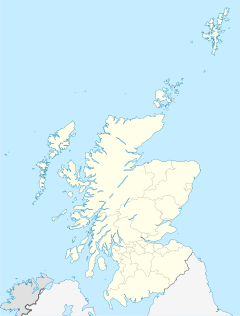Auchnacree facts for kids
Quick facts for kids Auchnacree |
|
|---|---|
| OS grid reference | NO464638 |
| Council area | |
| Lieutenancy area | |
| Country | Scotland |
| Sovereign state | United Kingdom |
| Ambulance | Scottish |
| EU Parliament | Scotland |
Auchnacree is a large area of land, also known as an estate, located in Angus, Scotland. It is about five miles north of a town called Forfar. This quiet place became famous for an important discovery from a very long time ago.
Contents
What is Auchnacree?
Auchnacree is a beautiful estate in the Scottish countryside. An estate is usually a large piece of land with a big house and other buildings, often used for farming or as a private property. It's part of Angus, Scotland, which is a council area on the east coast of Scotland. The area is known for its rich history and stunning natural landscapes.
The Amazing Auchnacree Hoard
In 1921, something very exciting was found at Auchnacree. A person named Mr. Frank Rae, who was in charge of looking after the estate, discovered a collection of ancient objects. This special find is now known as the Auchnacree Hoard. A "hoard" is a hidden collection of valuable items, often buried in the ground. Discovering a hoard is like finding a treasure chest from the past!
What Was Found?
The Auchnacree Hoard included several items made of bronze. Bronze is a strong metal created by mixing copper and tin. The objects found were:
- Two knives
- Three axeheads
- One armlet (a type of bracelet worn on the arm)
These items are very old, dating back to the early Bronze Age. The Bronze Age was a period in history when people started using bronze to make tools, weapons, and jewelry. This time period was before iron was widely used.
Why Was It Buried?
Archaeologists, who are like history detectives, have studied the Auchnacree Hoard carefully. They noticed something interesting: some of the bronze objects seemed to have been broken on purpose. This suggests that the hoard might not have just been a lost collection of items. Instead, it could have been a "ritual deposit."
A ritual deposit means the items were buried as part of a special ceremony or offering, perhaps to gods or spirits. People in ancient times often buried valuable objects for religious reasons or to mark important events. If the items were deliberately broken, it might mean they were "killed" or taken out of use before being offered. This is different from a "lost cache," which would just be items accidentally left behind and forgotten. The idea of a ritual deposit makes the Auchnacree Hoard even more mysterious and fascinating!
Life in the Bronze Age
The Auchnacree Hoard gives us a peek into the lives of people living in the Bronze Age. This period in Scotland lasted from about 2500 BC to 800 BC. It was a time of big changes, as people learned new skills and ways of living.
Tools and Art
During the Bronze Age, people became very skilled at working with metal. They made tools like the axeheads found in the Auchnacree Hoard, which were used for cutting wood or in farming. Knives were important for daily tasks. The armlet shows that people also created beautiful jewelry and decorative items. These objects tell us about their technology, their daily lives, and even their artistic abilities.
Ancient Scotland
The discovery of hoards like the one at Auchnacree helps us understand how ancient communities lived in Scotland. These finds show that people were connected to wider networks, as the knowledge of making bronze spread across different regions. They also highlight the importance of rituals and beliefs in their society. Every artifact found tells a story about the people who made and used it thousands of years ago.


